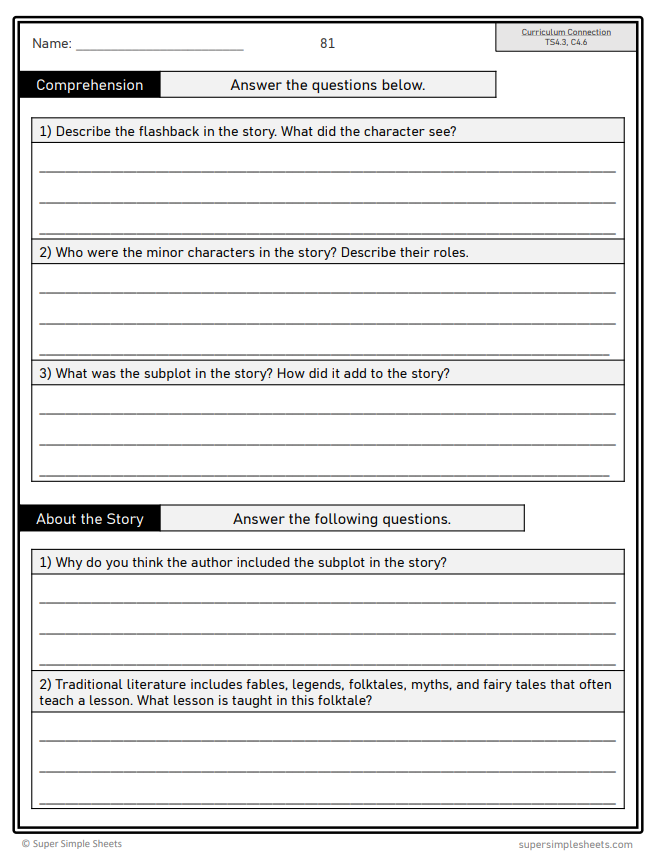Grade 4 - Reading Comprehension Unit - Alberta Language - Lesson/Workbook Bundle
Grade 4 - Reading Comprehension Unit - Alberta Language - Lesson/Workbook Bundle
Interested in a bundle? Shop below instead!
Couldn't load pickup availability
Grade 4 - Reading Comprehension Unit - Alberta Language Curriculum - Lesson/Workbook Bundle. This bundle was created to provide everything you need to teach the Grade 4 Reading Comprehension unit in the Alberta Language Curriculum.
With your purchase, you will receive lesson slides that follow the 3-Part lesson format, engaging your students from start to finish. You will also receive the workbook, which contains fun activities and worksheets for your students to demonstrate their understanding.
Workbook Details:
This resource covers all skills and procedures in the organizing ideas: Text Forms and Structures as well as Comprehension. The 326 pages teach the skills and procedures in these two curriculum areas.
We’ve included a variety of activities, including independent reading responses, group activities, assignments, experiments, exemplars, and hands-on activities to keep your students engaged.
Included in this resource are the organizing ideas below:
Text Forms and Structures: taught throughout the unit, with the use of 10 different blocks of text forms, including narratives, reports, poetry, comic strips, letters, procedural writing, book reviews, persuasive writing, and biographies.
Comprehension: as students learn about the text forms and structures of different types of writing, they will practice reading comprehension skills. They will read these different text forms, and use before reading, during reading, and after reading comprehension strategies – inferencing, visualizing, predicting, summarizing, making connections, synthesizing, and questioning. We have also included an independent reading response booklet.
In addition, we have included a full-year long range plan that outlines what concepts from the curriculum you will be teaching each week/block.
Some of the concepts covered:
- What are text forms?
- Different types of literary forms – novels, media texts, and journal entries
- Before reading: comprehension strategies – activating prior knowledge and reasons for reading
- During reading: comprehension strategies – questioning, making connections, inferences, predictions, visualizing
- After reading: comprehension strategies – summarizing, synthesizing, making inferences, visualizing
- Genres in text forms – fiction and non-fiction
- Sub-forms of genres – humour, adventure, traditional literature, fantasy, mystery, science fiction, horror, etc.
- Traditional literature – fables, myths, folktales
- Letter writing – emails, formal and informal letters, writing with voice
- Narratives – use of literary devices: personification, analogy, idiom
- Perspective in narratives – first-person, second-person, and third-person narration
- Narratives – subplots and flashbacks in story writing
- Major and minor characters in narrative writing
- Structure in stories – beginning, middle, end
- Personal wonderings in stories – what would you do differently?
- Making inferences about persuasive texts
- Text features in reports – index, glossary, timelines, headings, subheadings, graphics, etc.
- Using graphics and images in reports to help the reader understand the text
- Synthesizing reports – Climate Change
- Problem/solution reports and cause and effect reports
- Summarizing reports – determining the main idea and supporting details
- Use of infographics, timelines, maps, diagrams, and pictures in reports
- Literary devices used in poetry – personification, idiom, and analogy
- Assignment – examining poems written by Indigenous authors
- Understanding haiku, limericks, acrostic poems, cinquain poems, free verse, concrete, and rhyming poems
- Poetic terms – stanza, verse, free verse, rhyming, syllables, and rhythm
- Reading different styles (voices) in book reviews
- Text features in comics, infographics, memes, and maps
- Text features in biographies – using a glossary and indexes to understand a biography
- Biographies – Jane Goodall, Charles Darwin, Archimedes, Hiawatha: index and glossary
- Autobiographies – Justin Trudeau and Bill Gates
- Procedural writing – text forms: lists, title, graphics, and labels
- How graphics improve procedural writing
- Following instructions – drawing a totem pole and a tipi
- Answer pages for all activities
Google Lesson Slides
Grade 4 - Reading Comprehension Unit - Google Lesson Slides - Alberta Language Curriculum. This resource is packed with all the lessons you need to teach the Reading Comprehension, Grade 4, Alberta Language Curriculum.
We have structured these lessons to follow the popular 3-Part Lesson format. By using these lessons, you will be provided with learning goals, discussion questions, relevant YouTube videos, interactive slides, exit cards, and more. Check out the variety of activities you'll receive below.
Part 1: Minds On!
- Learning Goals
- Discussion Questions
- Quotes
Part 2: Action!
- Interactive Activities
- Drag and Drop
- Fill in the Blanks
- Matching
- Drawing
- Writing
Part 3: Consolidation
- Exit Cards
- Quizzes
- Reflection
After purchasing this resource, you will be able to download a copy of this file to your Google Drive. From there, you can complete these lessons with your class, and/or assign these slides in Google Classroom.
Share















